| |
Sharing ideas and good practice...
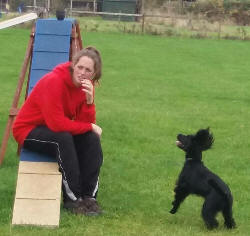 With
the age of social media age well and truly here, itís not uncommon to
hear of 'poor practice' at places which offer Beginners classes. Rather than just complain about it,
top trainer and competitor Selena Bray decided to do something to help improve the methods used to train
agility newbies so she wrote this articles for Agilitynet. Here are just a few
suggestions or games and exercises which can be used to build handler
knowledge and canine fitness and confidence. With
the age of social media age well and truly here, itís not uncommon to
hear of 'poor practice' at places which offer Beginners classes. Rather than just complain about it,
top trainer and competitor Selena Bray decided to do something to help improve the methods used to train
agility newbies so she wrote this articles for Agilitynet. Here are just a few
suggestions or games and exercises which can be used to build handler
knowledge and canine fitness and confidence.
It's my fear that the agility training
profession is in danger of becoming a 'pop up' business. Teaching agility
is a great opportunity for some people to make a fast buck. It can be difficult
- and potentially dangerous - for new handlers to find good place where they can
train in a safe environment.
I don't think we can
change things by complaining about them and I hope that this article will help
both these people who are starting out and those trainers who are looking for
tips on introducing agility to newbie handlers.
My foundation classes
are a bit like circuit training. I believe that there should be small short
sequences of work - a lot of it kit free. It's the trainer's job to keep the
motivation.
Here are a
few examples of the sort of thing you could expect from a Foundation class.
Always take your toys and treats to be best prepared for the potential
activities you might be doing.
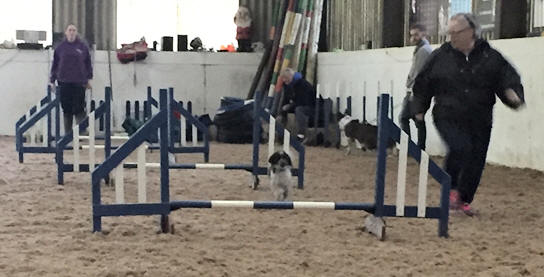
Jumps
Any dog can jump but there are not
that many that are good at it! Thereís no rush with the jump heights. We need to
teach the dog how to jump well.
In the beginning, the
poles should be on the floor. Once the dog and handler are confidently
negotiating them - and the dog is fit enough and old enough - the poles can
begin to be raised. This could be over a number of weeks or even months. Itíll
take a good amount of time to build the partnership up to cope with handling
communication.
Straight
lines of jumps help dogs to negotiate at speed, building the energy and will to
drive forward as quickly as possible. They are also great for 'send aways' and
'chasers.'
Here are
some exercises that can be done.
-
Poles on the
floor
Put a number of poles in a row to introduce the dog to the fact that
they are to be taken above. It helps the dog to become aware of their feet
and is the very beginning to scattered poles.
-
Wings of jumps in
a row without poles
The wings in a row as wide as you like and you do the games listed under
homework/takeaway but between those jump wings. Once your dog is becoming
good at that start to do the similar versions but to the side of the jump
(still inside) then eventually run down the outer side.
-
Jumps with poles
Place poles on the floor and do the same games as above.
-
Send aways
Practice send aways by using the same straight line of jumps. Put a
favourite object at the end of the row and send them in. The send away
can be created by different methods a) Throw the toy, making sure it
lands after the last jump and let your dog chase the toy to complete the
row. b) Place the toy at the last jump, taking the dog with you to show them where their toy is
or c) Return to the beginning of the row, promoting the toy over and over. Then
release and send them down the line of jumps.
-
Recall
Ask for wait or have someone restrain your dog. Then recall the dog through
the row of jumps
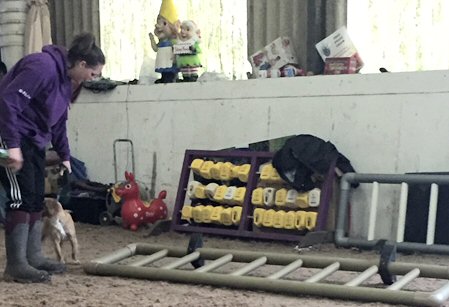
To help the dog to
understand the art of jumping, we do grids, backend awareness and cavaletti.
These exercises help teach handlers how to communicate physically with the dog
while, at the same time. ot builds the dog up with the structure to cope with
all we ask while doing agility.
-
Triangle grid
As the dog negotiates one jump, the next one is already in their sights, so
it is easier for them to complete than turn back. As soon as the dog is
happily taking these trio of jumps, the handler should not hang around, send
in and run the opposite way to draw the dog out faster.
-
Straight grid
Much like the introduction to the jump but the poles are purposefully
arranged in distances apart to build the dogs jumping ability.
-
Slice grid
Same as above but at diagonal angles.
-
Scatter poles and
cavaletti
This can be an 'on lead' thing, especially at first. The aim is to get the
dog to walk through the Chicane without touching the poles with it's feet.
Over time, they begin to understand where their feet land without having to
over think it and will do so easily without mistake. The same technique can
be done using a ladder and working through the steps front and back feet,
just front side to side and just back feet side to side, even backwards and
reverse down the ladder.

Teaching turns
Our aim is to make the dogs and
handlers understand all of the different styles of turn. We can do this using
just one obstacle such as a jump, barrel, pole or cone. The severity of the turn
taught depends upon the age of the dog. Again, at first there is no need for any
height.
Then add another jump in
order to teach the dog to run into the turn and be just as tight and effective.
Box work helps the dog
to understand the importance of listening to the commands and negotiating the
jumps to the left or right or straight ahead as necessary and also builds
independence value.
Other
obstacles
Thus far I have only
looked jumps although there are obviously other pieces of equipment to teach.
-
Tunnels
Start off with fantastic tunnel games, using shorter and straight tunnels.
-
Contact
The contacts should be on the floor or, even better, just concentrate on end
games . Wobble boards can be usedto prepare the dog to negotiate the surface
and understand the expectation at the end of the contact.
-
Weaves
If weaves are taught, it is a good idea to start with channel weaves.
Open
them very wide so as not to touch the dogs sides at all. Basically just
recall the dog between the two rows of poles. Other methods can be used but
probably should be started later as it takes time to build a dog's muscles
up to cope with the movement.

Introducing distractions
Part of foundation training for
pups and young dogs is keeping the dog's attention while other dogs play and
move around the area -not dissimilar to the show atmosphere.-These games should
be fun and kept short to make sure they are maintaining attention.
-
Ask the group to
form a circle with a good amount of room between each person. While everyone
plays with their dog and having fun, one handler will attempt to weave
between the others, trying to keep focus and attention.
-
Organise the
handlers into two lines with a gap between each person. Then one at a time,
get them to do the chasers from the top, again maintaining focus.
-
Pole work is a great
way to teach various turns. Pole turns are great fun and help the person
understand the handling elements on the agility course. Get everyone into a
circle. The handlers and dogs negotiate a pole at a time to do one type of
turn, and then move onto the next one to continue each do the same. It
should look like organised chaos.
-
Get everyone in the
group to play tuggy games with their dogs. Then ask them to move closer and
closer - step by step - in towards each other. If a dog loses connection
with the handler, they should move back out to gain focus before attempting
to return.
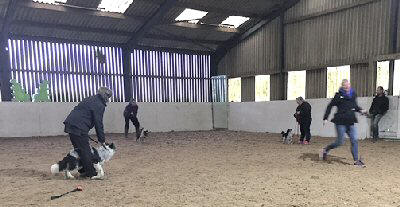
Homework / take away!
The following games should be fun
and kept at short time elements to make sure they are maintaining attention.
Make sure to steer clear of boring activities. We always celebrate and reward
with the dogs.
-
Chasers
The idea is to get the dog to chase the handler, really wanting to get
them to play. This can be done by one person holding the dog while the other
person runs away with something of interest to the dog. As the dog is
released and approaches, the handler makes connection with the dog and
celebrates.
-
Chasers with
treats / toys
The handler begins to run out, as above, however, they have the right
arm out with items of interest in it. As the dog is released, they bring the
right arm in and put the left arm out instead, attracting the dog to the
opposite side. This would be training the blind cross in front of the dog
and helping them to read the correct side to come to.
-
Chasers with a
front cross
This time we are going to do a front cross instead which that means we
will do a full 180í turn in front of the dog to bring them to opposite side.
This exercise helps them deal with confrontation, which a lot of dogs really
dislike.
-
Hide 'n Seek
This time while the dog is being held, the handler (runner) will go and
hide. When in place, release the dog to go and find, keep it simple and
obvious at first and increase the difficulty level, once they get the idea
of the game. Remember massive celebration on finding! I used to love playing
this game when I was young with our German shepherd, I think I found the
best hiding places because my dad always had to help her find me!
-
Send away and
chase to toy
Make the game fun and ensure the dog regularly wins. Keep it upbeat
especially if you have a dog which lacks motivation.
All of these games help
to build the value for the equipment and can be recreated at home or even on
general walks when on the lead - the only difference being that they are on the
lead. We want our dogs to really throw themselves into to exercises and have a
lot of fun but also safe.
Most of all, prepare to
have a laugh
and you'll get the best out of each dog and handler partnership. The biggest
must in any good training centre is play, reward and celebrate!
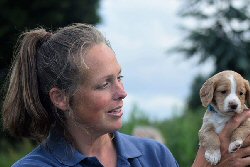 About
the author... About
the author...
Selena Bray has been doing agility for over 30 years, coming through
the KCJO (now known as YKC) as a young nipper!
She's always managed to
adapt and compete to the highest level even though the skills of agility have
vastly changed over the years. She has trained and handled quite a few different
breeds and sizes of dog since 1993.
In addition to her day
job - like a 'real' job - she loves training people and their dogs and watching
them flourish. She runs her own club Fox Agility,
featured in The Agility Club Premiership League. She is known for her foundation
work, motivation, distance/ independence, weaves, contacts and sequencing
skills. She never loses sight for longevity of the health of the dog as well as
building abilities in a natural way, utilising games to build a fantastic
relationship between dog and handler.
Selena and her family
live in Hinckley, Leicestershire.
First published 21
May 2018
| |
|